House plants have recently become very popular, especially since the quarantine days of the COVID pandemic. The benefits of having houseplants include not only adding charm and elegance to your home, but also helping to reduce stress and purifying the air. But before you make an impulse purchase on the next plant that catches your eye, here are our 5 expert tips on how to arrange house plants in your home to help guide you with the process.
1. Choose the right plants
Even the most beautiful plant in the world looks sad and ugly when it's on the verge of dying. If you choose the right plants, then you're already 99% ahead. So what factors into choosing the right plants?
First, you need to choose the right plants for the environment of your home.
If your house does not get a lot of light, you shouldn't get a cactus, which is from the very sunny desert. If your house gets freezing cold in the winter, you shouldn't get a hoya, which is from the tropics. Learn about the plant you wish to bring home to ensure you can keep it happy. All the plants we sell on our website have detailed care instructions.
Another factor is the level of maintenance you would like to commit to.
If you're a frequent traveler or a busy (or forgetful) person, drought tolerant plants such as euphorbias that can go for weeks (or sometimes months) without any watering would be a good fit. On the other hand, some people enjoy babying their plants, frequently watering, misting, and fertilizing them. If this is you, needy plants such as bananas may be a better fit.
2. Find the best location to keep your plants healthy
Now that you chose your plants, it’s time to decide the best locations to keep them happy in your home.
Consider the microclimate for each house plant location inside the home.
If you wish to place a plant next to air conditioning or heating, be aware that it will be very dry, and will most likely kill plants that do not like drafts such as philodendrons.
Even on the same window pane, if you place one plant that gets hit with direct sun rays, and another identical plant right next to it that only gets indirect sun, one may prosper and one may slowly die.
Each spot in your home has different levels of light, humidity, and air movement. Be aware of these conditions before arranging your house plants. And also, don't forget that you can get extra help in the form of grow lights, humidifiers, and terrariums.
3. Find the best location that looks great with each plant
Now let's turn to the pure aesthetics side of arranging houseplants.
Do you have areas in the house that look empty? That could use some extra life?
Perhaps you have an empty spot on the bookcase, fireplace mantle, or kitchen table that you'd like to fill and decorate. Think about the type of plant you'd like in each of those spots while considering its growth habit.
Here is an example. You probably wouldn't want to clutter your kitchen table if you use it regularly for dining. A small plant that does not grow much would be suitable in this case. This small parlor palm adds a nice simple touch of greenery to the table, and lives a lot longer than cut flowers.

On a related note, you may want to add plants to make a statement or bring attention to things. You can use hanging plants to highlight or frame windows or skylights and trees to add vertical interest, such as for adding grandeur in an entryway.


In the left image, the potted agave adds a welcoming message and brings attention to the main door of the building. It also hints at the style of the interior before you walk in.
The opposite of bringing attention to areas with house plants is covering things up. It's a clever way to hide blemishes or clutter.
In the right image, the large, potted ZZ plant hides cable and wire clutter, while adding life and greenery to the office.
4. Get creative with the color, texture, and shape of your plants and planters


Don't be afraid to experiment with different colors, textures, and shapes to see what works best for you and your space. Here are some tips.
Integrate the color of the plants as well as their pots and planters to your home decor.
The syngonium strawberry, pictured above, is pink, which is an unusual color for a plant. You could group it with other pink house plants such as pink princess philodendron and stromanthe triostar for a luxurious yet playful look.
Also notice that the planter has a bold, geometric design, which could be integrated with other patterns present in wallpaper, rugs, and and framed art.
All plants and simple terracotta planters fit well with any stylistic setting, whether vintage, mid-century modern or art deco. However, when using more distinctive planters, make sure they look cohesive with the rest of the interior.
Place a single plant in an empty space to create a focal point like the parlor palm on the kitchen table mentioned previously. The simplicity of the plant complements the bold color and pattern of the vase well.
Alternatively, group plants together to create a more natural and lush look.
In the image to the right, the cluster of tropical plants create a lush look even though each of them are relatively small. The green hedge outside the window enhances the tropical look.
Finally, embrace diversity. Having only trees or vining plants will most likely look unnatural. Having different plants of different shapes and sizes will make the interior look more relaxed and add to visual interest.
5. Use plants as living art
The last tip for arranging plants is to use them as if they were artwork.
Some plants, such as agaves and air plants, look like living sculptures. Use them as a main focal point and for a more dramatic impact, keep them in a clutter-free area.

Another plant that looks like artwork is the pancake plant as pictured above.
You can also use the immediate area of the plant to frame it like a painting or photograph. You can create an elaborate vertical plant wall or a simple shelf to create the plant display.

To the left is an example of a wall shelf set that you could use to frame your plants. Source: Amazon
Closing remarks on arranging house plants
Arranging house plants is a fantastic way to elevate your home interior. Remember- picking out the right plants and their proper locations to ensure they stay healthy and happy is the most important part of the process. From there, have fun experimenting and getting creative with them to help make your home feel like home.

